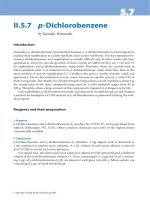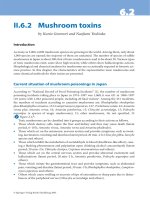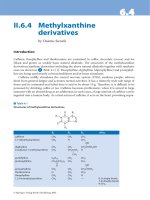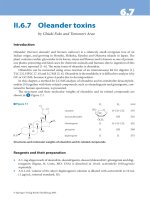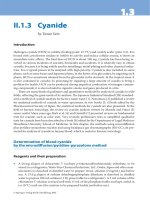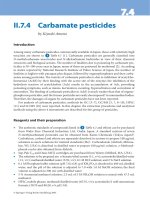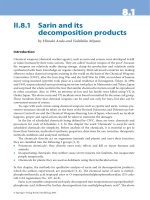INSIGHTS AND PERSPECTIVES IN RHEUMATOLOGY docx
Bạn đang xem bản rút gọn của tài liệu. Xem và tải ngay bản đầy đủ của tài liệu tại đây (7.99 MB, 286 trang )
INSIGHTS AND
PERSPECTIVES IN
RHEUMATOLOGY
Edited by Andrew Harrsion
Insights and Perspectives in Rheumatology
Edited by Andrew Harrsion
Published by InTech
Janeza Trdine 9, 51000 Rijeka, Croatia
Copyright © 2011 InTech
All chapters are Open Access distributed under the Creative Commons Attribution 3.0
license, which allows users to download, copy and build upon published articles even for
commercial purposes, as long as the author and publisher are properly credited, which
ensures maximum dissemination and a wider impact of our publications. After this work
has been published by InTech, authors have the right to republish it, in whole or part, in
any publication of which they are the author, and to make other personal use of the
work. Any republication, referencing or personal use of the work must explicitly identify
the original source.
As for readers, this license allows users to download, copy and build upon published
chapters even for commercial purposes, as long as the author and publisher are properly
credited, which ensures maximum dissemination and a wider impact of our publications.
Notice
Statements and opinions expressed in the chapters are these of the individual contributors
and not necessarily those of the editors or publisher. No responsibility is accepted for the
accuracy of information contained in the published chapters. The publisher assumes no
responsibility for any damage or injury to persons or property arising out of the use of any
materials, instructions, methods or ideas contained in the book.
Publishing Process Manager Ivana Zec
Technical Editor Teodora Smiljanic
Cover Designer InTech Design Team
Image Copyright Eraxion, 2011. DepositPhotos Used under license from
Shutterstock.com
First published December, 2011
Printed in Croatia
A free online edition of this book is available at www.intechopen.com
Additional hard copies can be obtained from
Insights and Perspectives in Rheumatology, Edited by Andrew Harrsion
p. cm.
ISBN 978-953-307-846-5
free online editions of InTech
Books and Journals can be found at
www.intechopen.com
Contents
Preface IX
Part 1 Pathogenic Mechanisms in Rheumatic Disease 1
Chapter 1 Natural and Pathologic Autoantibodies 3
Péter Németh and Diána Simon
Chapter 2 Adipokines and Systemic Rheumatic Diseases:
Linking Inflammation, Immunity and Metabolism 21
Morena Scotece, Javier Conde, Veronica Lopez, Rodolfo Gómez,
Francisca Lago, Juan J Gómez Reino and Oreste Gualillo
Chapter 3 Gene Expression Profiling in Rheumatoid Arthritis 39
Cornelis L. Verweij and Saskia Vosslamber
Chapter 4 Vitamin D and Autoimmune Disease 63
Ayah M. Boudal and Suzan M. Attar
Chapter 5 Osteoporosis in Rheumatoid Arthritis 75
Alessandro Geraci
Chapter 6 Infectious Complications of Anti-Tumour Necrosis
Factor-α Therapy in Rheumatoid Arthritis 93
Ioannis D. Xynos and Nikolaos V. Sipsas
Chapter 7 Pamidronate Treatment in Charcot Neuro-Osteoarthropathy:
Change in Biochemical Markers of Bone Turnover and
Radiographic Outcome After Treatment 109
Ivonne Vázquez, Mireia Moreno and Marta Larrosa
Part 2 Sjögren's Syndrome:
Clinical and Immunological Aspects 121
Chapter 8 Diagnostic and Prognostic Features
of Sjögren’s Syndrome 123
Muhammad S. Soyfoo and Elie Cogan
VI Contents
Chapter 9 Oral Aspects of Sjögren’s Syndrome 149
Sertan Ergun
Chapter 10 Mechanisms of Salivary Gland Secretory
Dysfunction in Sjögren’s Syndrome 171
Kaleb M. Pauley, Byung Ha Lee,
Adrienne E. Gauna and Seunghee Cha
Chapter 11 Sjögren’s Syndrome: The Proteomic Approaches 193
Laura Giusti, Chiara Baldini, Laura Bazzichi,
Stefano Bombardieri and Antonio Lucacchini
Part 3 Psychosocial Considerations in Rheumatic Disease 213
Chapter 12 The Pathogenetic Link Between
Stress and Rheumatic Diseases 215
O. Malysheva and C.G.O. Baerwald
Chapter 13 Pain in Rheumatic Diseases 241
Susette Unger and Christoph Baerwald
Chapter 14 Transition of Care in Rheumatology:
Managing the Rheumatic Patient
from Childhood to Adulthood 255
Philomine van Pelt and Nico Wulffraat
Preface
Over the past two decades, there has been remarkable progress in the understanding
of pathogenesis of rheumatic disease, which has in turn led to dramatic improvements
in the ability to control inflammation. In documenting some of the advances that have
taken place, this book demonstrates the therapeutic possibilities that fields such as
pharmacogenomics might bring, while highlighting the current challenges in
rheumatology, such as prevention of treatment-related opportunistic infection and the
control of chronic pain.
The first section is concerned with the pathogenesis mechanisms that underlie
rheumatic diseases, beginning with a review of autoantibodies and their role in
disease pathogenesis. There is a chapter on adipokines; the inflammatory mediators
produced by adipose tissue, and the relationship between metabolism and
inflammation. The results of microarray studies are outlined within a review on gene
expression profiling in rheumatoid arthritis. The role of vitamin D in autoimmune
disease is deliberated and there is a chapter that examines the effects of rheumatoid
arthritis on bone metabolism. The first section concludes with a review of great clinical
relevance – the contribution of TNF inhibitors to the risk of infection in rheumatoid
arthritis.
The second section narrows the focus to discuss various aspects of one particular
rheumatic disease; Sjögren’s syndrome. This section is not intended to be a monograph
on this disease, but more of a collection of reviews that put the spotlight on specific
interesting facet of Sjögren’s syndrome: diagnosis and prognosis, mechanisms of
decreased glandular secretion, oral manifestations and salivary proteomics.
The final section of the book moves away from somatic physiology and pathology and
examines the impact of the rheumatic diseases on higher functions. The role of
psychological stress in the presentation of rheumatic disease is reviewed, and there is
a chapter on assessment and management of pain. The transition of JIA patients, from
childhood to adulthood, is reviewed in the final chapter of this section.
The hope is, that this book will serve as a resource for those seeking comprehensive
reviews of these topics. In its entirety, this book demonstrates the breadth and depth
X Preface
of knowledge that has been accumulated in rheumatology from the molecular level to
the highest level of human function.
Dr. Andrew Harrsion
University of Otago,
New Zealand
Part 1
Pathogenic Mechanisms in Rheumatic Disease
1
Natural and Pathologic Autoantibodies
Péter Németh and Diána Simon
University of Pécs, Department of Immunology and Biotechnology
Hungary
1. Introduction
Detection and characterization of autoantibodies reacting with self-antigens is generally
used in laboratory diagnostics. However, the presence of different autoantibodies in the
blood serum doesn’t mean automatically a pathologic condition. Autoantibodies are present
both in different diseases as autoimmune diseases, chronic inflammation or infections, and
in healthy individuals without any symptoms. The present paper discusses the detailed
analysis of recognition pattern and fine epitope specificity of these autoantibodies to better
understand of their occurrence and evolution, and their role in physiologic and pathologic
conditions.
1.1 Evolution of the immunological recognition
Microorganisms present in the environment continuously come into contact with the human
body through external or internal surfaces. Most microorganisms are neutral or useful, but
others – so called pathogens - are dangerous for the other living beings including human
individuals. During evolution all multicellular organisms have developed defence
mechanisms capable of eliminating these invading pathogens without causing damage to
self structures. All vertebrates and invertebrates manage self and non-self discrimination.
Consequently, discriminating self from non-self is of key importance for directing immune
functions effectively, operating on the basis of distinct recognition systems. Any attempt to
answer questions concerning recognition must consider the universality of receptor-
mediated responses. These may be designated to two forms: pattern recognition receptors
and rearranging clonally distributed antigen-specific receptors that distinguish between self
and non-self.
1.1.1 Pattern recognition as a basic immune function
Innate immunity serves as first line of defence against pathogens. Its early evolutionary
appearance is indicated by its presence in all multicellular organisms including plants,
invertebrates and vertebrates. Since invertebrate species rely on innate defence mechanisms
only, survival of the species in the presence of environmental pathogens is achieved at the
level of the population, which means that individual members, up until a fraction of total
population, are dispensable (Kvell et al., 2007). Innate immunity uses receptors that are
ancient in their evolutionary origin. These non-clonally distributed receptors have to be able
to recognize a wide variety of molecular structures associated with pathogens without
Insights and Perspectives in Rheumatology
4
damaging self-structures. The problem lies in the discrepancy between the vast
heterogeneity of pathogens and the limited number of possible recognizing receptors in the
genome. This implies that the relatively few available specific receptors must recognize
structures shared by large groups of pathogens, and that the recognized structures have to
be pathogen-specific molecular patterns rather than particular molecules specific for
pathogens. These pathogen associated molecular patterns (PAMPs) are conserved products of
microbial metabolism, they are highly glycosylated, and are essential for microbial survival.
The receptors recognizing these PAMPs are termed pattern recognition receptors (PRRs). We
distinguish three functional classes of PRRs: endocytic receptors such as cellular C-type lectins,
scavenger receptors and Mac-1 (CD11b:Cd18), which facilitate opsonisation and phagocytosis.
This type of recognition is predominantly based on sugar-sugar interactions. The second set of
PRRs are secreted proteins including mannose binding lectin, C1q, pulmonary surfactant
proteins A and D, C-reactive protein and lipopolysaccharide binding proteins, respectively.
These molecules facilitate opsonisation for phagocytosis and aid the complement system in
destroying pathogens that have been bound by these secreted proteins (Medzhitov 2001). The
third functional group is constituted by signalling receptors such as the Toll-like receptors
(TLRs), which activate several intracellular signalling cascades, eventually leading to the
activation of many immune response genes. PAMPs are targets for many PRRs in innate
immunity. PRRs are expressed on cells positioned strategically in the first line of pathogen
encounter such as surface epithelia, marginal zone of spleen, and on antigen presenting cells
(APCs) such as macrophages and dendritic cells. It is important to note that the relatively
broad spectrum of ligands recognized by TLR family members also includes glycoproteins,
which points toward the adaptive recognition system (Klein & Nikolaidis 2005). Thus, the TLR
family possibly represents an important milestone on the way to a recognition system
characteristic for adaptive immunity (Cooper et al., 2006).
Recognition of PAMPs can activate direct effector mechanisms of innate immunity such as
phagocytosis, secretion of antimicrobial peptides and induction of nitric oxide synthase in
macrophages. Activation of innate immunity results in the secretion of several inflammatory
cytokines such as interleukin-1, interleukin-6, tumor necrosis factor-α, type I interferon and
many chemokines. One of the most important events caused by PAMPs recognition is the
surface expression of CD80 (B7.1) and CD86 (B7.2) co-stimulatory molecules on APCs,
which is necessary for the priming of T-dependent adaptive immune responses. Therefore in
addition to activate direct first line defence mechanisms, innate immunity substantially
contributes to the adaptive response as well. It is important to note that while PRRs
recognize molecular patterns instead of specific molecules, and significant redundancy and
promiscuity exists in the molecular nature of the recognized ligands, PRRs discriminate
infectious non-self from self perfectly. One plausible explanation for this is that PRRs were
selected and genetically stabilized over an evolutionary time scale creating an advantage for
survival, and organisms possessing self reactive PRRs were eventually eliminated. This
process prevents autoimmunity in those organisms which have only the innate recognition
system (Cooper et al., 2006; Kvell et al., 2007).
1.1.2 Antigen specific recognition
The adaptive immune system containing specialized organs (bone marrow, thymus, spleen,
lymph nodes, highly structured lymphatic tissues associated with the wet and dry body
Natural and Pathologic Autoantibodies
5
surfaces), that provide appropriate microenvironment for cells which are committed to
antigen specific immune defence (T and B cells), appeared later during the evolution. It can
be generally found in jawed vertebrates, however the earliest species with a variable antigen
receptor based adaptive-like recognition system are jawless fish (lamprey, hagfish). These
fish have non-immunoglobulin like clonally distributed receptors with leucine-rich repeats
(similar to TLRs) generated with a gene rearrangement mechanism other than the
recombination activating genes (RAG-1:RAG-2) characteristic for jawed vertebrates (Pancer
et al., 2004). The appearance of adaptive immune system in jawed vertebrates gives the
impression of a “sudden” change between jawless and jawed fish. This “big bang”
hypothesis concerning gene duplication events, acquisition of a retrotransposon and the
appearance of molecules such as major histocompatibilty complex, T- and B-cell receptors
(Abi Rached et al., 1999) has been challenged by showing that integration of minor changes
accumulated over an extended evolutionary time lead to the appearance of adaptive
immune system (Klein & Nikolaidis 2005). Taking into consideration the major
immunological recognition and activation theories from Janeway’s self/non-self recognition
to Polly Matzinger’s danger hypothesis and from Burnet’s clonal selection to Smith’s
quantal theory recently, there is a trend to synthesize the self/non-self vs. danger models,
particularly proving that receptors distinguish pathogen and danger signals simultaneously
(Liu et al. 2009).
In vertebrates the adaptive immunity generates a virtually indefinite pool of recognizing
molecules: the T and B cell receptors (TCR, BCR), which repertoire makes the adaptation of
each individual to pathogenic challenges possible. According to the clonal selection
hypothesis these receptors are clonally distributed, each of them represented by single cell
clone. The benefit of the high number of available antigen receptors in adaptive immunity
comes with the cost of potentially dangerous recognition of self-structures, leading to
autoimmunity. Therefore carefully organized selection mechanisms exist to select the
potentially useful clones, and to eliminate or inactivate the autoreactive ones. Germline
genes encoding T and B cell receptors are rearranged by the site specific recombinases RAG-
1, RAG-2. Once these antigen receptors appear on the cell surface, the cell carrying them has
to survive two types of selection. The first of these is probing the utility of the expressed
receptor by testing whether it is capable to recognize its ligand in the microenvironment.
This selection step is termed positive selection, since in the case of the appropriate
engagement of antigen receptor the cell survives. Although the process was described first
and in more detail for T cells maturing in the thymus, it was also clearly demonstrated for B
cell maturing in the bone marrow and spleen (Cancro & Kearney, 2004). The ligand that
activates the antigen receptor is self-peptide-MHC complex and possibly soluble
immunoglobulin for T and B cells, respectively. Positive selection operates on a thin margin,
the strength of the signal generated by antigen receptor engagement must be lower than in
full activation, thus it provides a partial activation signal. The second selection step
eliminates clones that possess antigen receptors, which recognize self too strongly, and
termed negative selection. This mechanism is based on the full activation of antigen receptor
mediated signalling pathways by self antigens and eventually leads either to the deletion of
the cell clone, or to long term unresponsiveness of the cell to subsequent stimuli (anergy).
Alternatively, in the case of B cells, the recombination machinery could be re-activated and
the other immunoglobulin gene harbouring allele could be rearranged (receptor editing),
giving the cell a second chance to produce an antigen receptor not reacting with self
Insights and Perspectives in Rheumatology
6
structures above threshold. Thus, the selection of antigen receptor bearing cells, irrespective
of whether they belong to the T or B cell pool, is governed by interaction with self ligands
instead of non-self ligands. The generation of the adaptive immune repertoire is therefore
strongly self-referential (Janeway 2001).
2. Natural immunity
Since the innate recognition system discriminates self from non-self perfectly, the
contribution of innate immunity to the activation of adaptive responses seems to be of vital
importance for maintaining tolerance at the periphery. The appearance of co-stimulatory
molecules on APC surface is critical for the activation of both T and B cells. In the absence of
appropriate co-stimulation the activation signal remains below threshold level and the
adaptive immune response will not be activated. The innate and adaptive arms of the
immune system differ from each other in several important features and their cooperation is
essential for the correct function of immune defence. As a connection bridging the
evolutionarily oldest innate and the newly evolved adaptive systems a third compartment
of immune machineries, the natural immune system has recently been described. A distinct
set of lymphocytes – both T and B cells – with characteristic phenotypes and specialized
functions participates in this system. These subsets of cells exhibit common phenotypic
characteristics and posses both innate and adaptive features, suggesting a transitional stage
in the immune system’s evolution. The most important cellular components of the natural
immune system according to recent knowledge are the invariant natural killer T (iNKT)
cells, mucosa associated invariant T (MAIT) cells, γδ T cells and B1 B cells. The functional
character of antigen recognition by these cells (and the immunoglobulins produced by B1 B
cells) are closer to the pattern recognition features than to the classical adaptive type
immunological recognition, however, the recognizing molecules are genuine T and B cell
surface receptors.
2.1 Cellular elements of natural immune system
Among unconventional T cells, only two subsets display both a TCR and selecting MHC
class Ib molecules highly conserved between species, the iNKT cells and the mucosal
associated invariant T (MAIT) cells. These two populations express highly restricted TCR
repertoires consisting of an invariant TCRα chain. Both subsets are selected by
hematopoietic cells expressing evolutionarily conserved non-polymorphic MHC class Ib
molecules, CD1d for iNKT cells and MHC-related molecule 1 (MR1) for MAIT cells. CD1d-
restricted iNKT cells and MR1-restricted MAIT cells constitute two subsets of
unconventional T cells that are phylogenetically conserved. Therefore, they are thought to
play an essential role within the immune system of mammals (Treiner et al., 2005).
MAIT cells are selected by MR1 in the thymus on a non-B non-T hematopoietic cell, and
acquire a memory phenotype and expand in the lamina propria of the gastrointestinal tract
and in mesenterial lymph nodes in a process dependent both upon B cells and the bacterial
flora. Thus, their development follows a unique pattern at the crossroad of iNKT and γδ T
cells. These features suggest that MAIT cells could be involved in tolerance or immunity to
infections in the gut. The function of MAIT cells is unknown, but intuitively we can argue
that it is related to their localization in the gut mucosa. MAIT cells could somehow be
Natural and Pathologic Autoantibodies
7
involved in the defense against orally acquired pathogens or in non-immune function
important for gut mucosa homeostasis. MAIT cells might also control the type of the gut
immune response and/or be involved in oral tolerance. Controlling the balance between
tolerance and immune response in the gastrointestinal tract is highly important, and could
explain the striking conservation of the MAIT cells across species. The functional relevance
of MAIT cells is also underlined by the fact that they represent 1-4% of peripheral T cells in
human blood (Treiner et al., 2005).
iNKT cells are selected, expand, and acquire their innate-like phenotype and functions in the
thymus. They accumulate in the liver and the spleen, independently of the presence of any
exogenous stimuli such as the normal bacterial flora. INKT cells play an important role in
both protective and regulatory responses. The nature of the response is determined by the
initial cytokine environment: interaction with IL-10-producing cells induces regulatory T
cell type iNKT cells and that with IL-12 producing cells results in Th1 type responses, while
their production of IFNγ activates both innate and adaptive immune systems. Upon
activation of iNKT cells tumor cells can be efficiently eliminated and they also play a role in
the development of obesity (Lynch et al., 2009).
The γδ TCR repertoire similarly to the repertoire of innate immune receptors could have
been selected through evolution. Thymic selection does little to constrain γδ T cell antigen
specificities, but instead determines their effector fate. In general, it is believed that γδ T
cells recognize host antigens and play a role in epithelial cell maintenance. Intraepithelial
lymphocytes (IEL) ontogeny can show minimal dependency upon the thymus, as they can
escape the thymus at a very early stage and migrate into the gut mucosa where they achieve
maturation. They may even develop directly from bone marrow derived precursors in
specific intestinal lymphoid aggregates called cryptopatches. The absence of positive
selection, and the lack of antigen specific priming, seems ideal for γδ T cells to function in
the first line of defence. When activated through the T cell receptor, antigen-experienced
cells make IFNγ, whereas antigen-unexperienced γδ T cells produce IL-17, a major initiator
of inflammation. One of the main functions of IL-17 is to promote the expansion and
maturation of neutrophils in the bone marrow. Therefore the rapid IL-17 response mounted
by antigen-inexperienced γδ T cells would play a critical role at the onset of an acute
inflammatory response to pathogens that the host encounters for the first time, or to host
antigens that are only revealed by injury. Furthermore, by acting early in the inflammatory
response, γδ T cells may affect the development of antigen specific αβ T cell and B cell
responses. Thus γδ T cells may play a much larger role in the adaptive immune response
than previously recognized. Since γδ T cells contribute to host immune competence in
several ways it is understandable why these cells have been maintained throughout
vertebrate evolution, even when αβ T cells and B cells are also present (Konigshofer & Chien
2006).
B1 B cells were originally distinguished from B2 cells on the basis of their expression of CD5,
a glycoprotein marker previously considered to be T cell specific. CD5 is a type I
transmembrane glycoprotein with three scavenger receptor cysteine rich domains and a
highly conserved intracellular domain. Its role in signalling was extensively studied both in
T and B cells. As it is associated with antigen receptor signalling complexes, the CD5
molecule considered to be a negative regulator of TCR and BCR signalling. Later on a CD5-
B1 B cell population was also identified and termed B1b B cells. Differences in the function
Insights and Perspectives in Rheumatology
8
and developmental requirements of the two B1 B cell subgroups are poorly characterized;
however, it seems that the BCR/CD19 complex is of crucial importance in developmental
decisions between B1a and B1b B cells (Haas et al., 2005).
In addition to surface phenotype, B1 B cells have several unique properties distinguishing
them from conventional B2 cells. B1 B cells represent a self-renewing population found in
high number in the peritoneal and pleural cavities, while they are virtually absent from
peripheral lymph nodes and can be found in low number among splenic B cells. They are
long lived in vitro, can be forced with phorbol esters to proliferate, and they could not be
activated through BCR crosslinking. The immunoglobulin repertoire of B1 B cells is
restricted in the number of immunoglobulin genes used; it is dominated by rearrangement
of J-proximal V genes and has significantly fever N insertions than the repertoire of B2 cells
(Kantor et al. 1997).
There is a long-standing dispute over the developmental origin of B1 B cells in literature
(Haas et al., 2005). According to the lineage model, B1 B cells are generated from fetal
precursors present in the fetal liver, omentum and splanchnopleura. This view is
substantiated by the ability of fetal precursors to reconstitute both the B1 and B2
compartments in irradiated mice, while adult bone marrow-derived cells reconstitute B2
cells only. The induced differentiation model of B1 B cell development proposes that the B1
phenotype is a consequence of T-independent-2 like activation event, thus the specificity of
BCR is the key factor which determines the B1 phenotype. The differential ability of fetal vs.
adult precursors to generate B1 B cells is due to the different antigen receptor repertoire of
these precursors. This argument is supported by several transgenic models in which the
origin and specificity of the immunoglobulin transgene determined the B1 phenotype
(Chumley et al., 2000).
Functions of B1a cells include the participation in the early phases of immune responses and
most importantly the production of natural antibodies with dominantly IgM isotype, which
is substantiated by the ability of B1 cells transferred adoptively into irradiated mice to
restore normal IgM level. These lines of evidence and the properties of B1 B cell produced
natural antibodies indicate that B1 B cells represent an intermediate stage of evolution
between innate and adaptive immunity.
2.2 Natural (auto)antibodies
Natural antibodies are immunoglobulins mostly of IgM isotype, and are secreted by B1 cells
without immunization with antigen. These antibodies can recognize genetically conserved
sequences of pathogens and may serve in the first line of immune defence during an
infection. In contrast, natural autoantibodies present in the serum of both healthy humans
and patients with chronic inflammatory or systemic autoimmune diseases recognize a set of
self-structures that have been conserved during evolution. Most of natural autoantibodies
belong to the IgM or IgG isotype, and show polyreactivity with a broad range of affinities
for the recognized epitopes (Lacroix-Desmazes et al., 1998).
Several functions have been suggested for natural autoantibodies: they may participate in
the selection of immune repertoires, play a role in the acceleration of primary immune
responses, and the clearance of apoptotic cells, possess anti-inflammatory effects and
contribute to the maintenance of immune homeostasis (Lacroix-Desmazes et al., 1998).
Natural and Pathologic Autoantibodies
9
Discrimination of natural antibodies from natural autoantibodies is somewhat artificial since
given the limited B1 immunoglobulin gene repertoire driving natural antibody production
and the numerous distinct antigens recognized it is probable that specificities with self non-
self cross reactivity exist. Based on the above properties of natural antibodies, these
molecules could be considered as the “innate like arm” of humoral immune system
(Czömpöly et al., 2008).
3. Physiologic and pathologic autoantibodies
The phenomena that natural autoantibodies could recognize self antigens which are also
targeted by antibodies in autoimmune diseases are not unprecedented. Several lines of
evidence indicate that antibodies recognizing factor VIII, thyreoglobulin, DNA, endothelial
cell membrane components etc., are present in sera of both healthy individuals and patients
with autoimmune diseases. These findings raise the question whether these detected
antibodies are pathologic autoantibodies or belong to the pool of natural antibodies. It is
possible that the fine epitope pattern recognized by natural antibodies and disease
associated autoantibodies within the targeted antigen is different.
3.1 Characterization of fine epitope structure of the antibodies
There is a need for epitope mapping on circulating autoantibodies both in the basic and
clinical immunology and in the immuno-biotechnological research and development. A
mixture of different natural and pathologic autoantibodies is present in human blood
samples with various antigen specificity. All the classical physico-chemical and
immunochemical methods used in antibody characterization are technically difficult in the
case of autoantigens.
3.1.1 Methods for determination of epitope specificity
Several techniques are available for the chemical determination of fine specificity of
recognition molecules; however, a large scale analysis on serum samples from healthy
individuals and patients with autoimmune and other diseases is both theoretically and
technically difficult. Epitope mapping with overlapping synthetic peptides is a useful
technique, but its constraints include the uncertainties linked to in silico B cell epitope
prediction used for selection of antigenic regions, the partial coverage of primary sequence
by synthetic peptides and the possible loss of all unpredicted or conformational epitopes.
Synthetic overlapping peptides are suitable in the case of well characterized autoantigens.
Limited proteolysis and the following mass spectroscopic analysis are generally used
techniques in monoclonal antibody characterizations. Random peptide libraries were
developed for characterization of epitope specificity on circulating autoantibodies by M13
filamentous phage system. The method was optimized on monoclonal antibodies and
applied for serum samples. During our further development lambda phages were used to
display fragments of previously determined antigens. Bacteriophage surface display of
peptides is a recently used technique for a variety of applications. This technique resembles
most the physiological antigen conformation and does not require prior epitope prediction.
The technology is based on the expression of recombinant peptides or proteins fused to a
phage coat protein. Its key advantage is in the physical coupling of the displayed protein to
Insights and Perspectives in Rheumatology
10
the nucleic acid coding for it, making the repeated affinity selection and amplification
possible. The most commonly used systems are based on fusion to a filamentous phage coat
protein. However, the life cycle of these phages limits the size of the displayed peptide,
therefore we have chosen phage lambda for the epitope mapping of naturally occurring and
pathologic autoantibodies in our different studies. The library contains fragments of the
antigen with random starting point and length, consequently it overcomes the theoretical
and technical limitations associated with pre-designed fragments or overlapping synthetic
peptides (Czömpöly et al., 2008).
3.1.2 Epitope mapping of naturally occurring antibody family specific for the
mitochondrial citrate synthase protein antigen
The basic structural elements of living cells such as the cytoskeleton, metabolic organelles,
transporters, molecular components of transcription and translation etc., are genetically
conserved. The maintainence of immunological tolerance against these structures is a basic
functional duty of immune machinery in all of the three levels. The mitochondrion is
absolutely necessary for eukaryotic cell function. Genetic alterations which affect
mitochondrial proteins have serious consequences, if the mutation is compatible with life at
all. Because of their endosymbiotic evolutionary origin, proteins compartmentalized into
mitochondria represent an interesting transition from prokaryotic foreign to essential self
molecules. To date there are only a limited number of epitope mapping analyses performed
on human antigens that are recognized by natural autoantibodies. In particular, little is
known about the possible overlap between recognized epitopes of innate and self-reactive
natural antibodies. The structural and functional conservation of mitochondrial components
makes them candidate antigens for detailed analysis of evolutionary connections between
the innate and adaptive immune response. No classical mitochondrion-targeted
autoimmune disease – with the exception of the primary biliary cirrhosis is known,
suggesting a well established tolerance both at the innate and adaptive level. The inner
membrane enzymes, especially the citric acid cycle enzymes offer appropriate models for
testing their immunoreactivity, because they are in continuous connection with both innate
and adaptive components of the immune system during physiologic turnover of cells. The
immunological recognition and the immunoreactivity with these molecules are less studied,
and the possible changes in physiological autoreactivity under pathologic autoimmune
conditions remain largely unclear (Czömpöly et al., 2006). To address these issues we have
chosen a mitochondrial inner membrane enzyme, citrate synthase (CS) as model antigen for
epitope mapping using sera of healthy individuals and patients having various systemic
autoimmune disease (systemic lupus erythematosus (SLE), rheumatoid arthritis,
undifferentiated connective tissue disease, polymyositis/dermatomyosits, systemic sclerosis
(SSc), Raynaud’s syndrome and Sjögren’s syndrome). The CS enzyme is not only a
theoretically appropriate model – this is one of the first living protein during the evolution –
but has also been studied at gene, protein structure and functional levels.
We demonstrated the presence of antibodies recognizing CS in the sera of both healthy
individuals and systemic autoimmune patients. The enzyme specific antibodies with IgM
isotype were more frequently present in all investigated groups than those of IgG or IgA
isotypes and the incidence of autoantibodies with IgM isotype was significantly higher in
autoimmune patients compared to the healthy controls. We found that the reactivity against
Natural and Pathologic Autoantibodies
11
CS of individual sera remained permanently constant over a five year period (Fig.1.), in
opposite to the anti-CS antibodies with IgG isotype which showed various titer during the
investigated period on the same individuals. Our findings, that the majority of these
antibodies have IgM isotype, are already present in infants, and the long term stability of
their serum titers in adults indicate that these specificities belong to the natural
autoantibody repertoire established early in postnatal life. The occurrence of anti-CS
antibodies with IgG isotype we can explain as the physiologic dynamics of normal immune
defence against different pathogens.
0
0,2
0,4
0,6
0,8
1
1,2
1,4
1,6
1,8
CS reactivity (OD 492)
Fig. 1. CS reactivity in healthy individuals – 52 blood donors - followed up during a five
year period with IgM isotype specific indirect ELISA.
To compare epitopes recognized by natural autoantibodies in healthy individuals with those
recognized in systemic autoimmune patients we performed the epitope mapping of anti-CS
antibodies under physiological and pathologic (systemic autoimmune) conditions. Epitope
mapping with overlapping synthetic peptides is a widely used technique, but its constraints
include the uncertainties linked to in silico B-cell epitope prediction used for selection of
antigenic regions, the partial coverage of primary sequence by synthetic peptides and the
possible loss of all unpredicted or conformational epitopes. Since these effects could have
influenced our results, we sought to perform the epitope mapping using a basically different
technique. Bacteriophage surface display of peptides is an extensively used technique for a
variety of applications. The most commonly used systems are based on fusion to a
filamentous phage coat protein. However, the life cycle of these phages limits the size of the
displayed peptide, therefore we have chosen phage lambda for construction of a CS antigen
Base
3 year
5 year
Insights and Perspectives in Rheumatology
12
fragment library to analyze the fine epitope structure of anti-CS autoantibodies (Czömpöly
et al., 2006). The library contains fragments of CS with random starting point and length;
consequently it overcomes the theoretical and technical limitations associated with the
overlapping synthetic peptide approach. With this phage display based approach we
compared the epitope patterns recognized by anti-CS autoantibodies found in sera of
healthy individuals and patients with systemic autoimmune diseases. According to our
results there is no favoured region of the CS molecule recognized exclusively either by
healthy individuals or patients with systemic autoimmune diseases, but the fine epitope
pattern is different in the two groups examined (Fig. 2.).
50 100 150 200 250 300 350 400 450
B
A
Human CS amino acids
Fig. 2. Amino acid sequences of CS recognized by healthy individuals (A) and patients with
systemic autoimmune diseases (B)
3.1.3 Epitope mapping of pathologic autoantibodies specific for a well conserved
nuclear antigen, DNA topoisomerase I
Previously described experiments underlined the necessity for the epitope mapping of an
autoantibody which is specific for a well defined pathologic condition and has a high
diagnostic value. Our aim was to decide whether the target antigen of the disease associated
autoantibody is also recognized by naturally occurring autoantibodies. We assumed that
comparison of the epitope patterns recognized by natural and disease-associated
autoantibodies would contribute to the better understanding of the differences between
natural and pathologic autoantibodies. To address these issues we chose DNA
topoisomerase I as a model antigen, since anti-topoisomerase I antibodies are important in
the diagnosis of SSc.
Using the phage display technique previously developed in our department and optimized
by analyzing epitopes of anti-CS antibodies, we performed the epitope mapping of anti-
Natural and Pathologic Autoantibodies
13
topoisomerase I autoantibodies and examined whether the target antigen of the disease
associated autoantibody is also recognized by naturally occurring autoantibodies (Simon et
al., 2009).
With the help of the bacteriophage lambda library containing fragments of topoisomerase I
with random starting point and length we compared the epitope patterns recognized by
anti-topoisomerase I autoantibodies found in sera of patients with diffuse cutaneous SSc
(dcSSc), limited cutaneous SSc (lcSSc), and SLE. The results showed that the pattern of
recognized epitopes is different between dcSSc, lcSSc and SLE patients (Fig. 3.).
Human DNA topoisomerase I amino acids
Fig. 3. The pattern of recognized topoisomerase I epitopes is different between dcSSc, lcSSc
and SLE patients
A common fragment recognized by all patients’ sera was located in the region of amino acid
sequence (AA) 450-600, which is in agreement with previously published results. In addition
to this, sera of dcSSc patients recognized several short fragments at the N-terminal part of
the molecule. Previous studies performed with fusion proteins covering the N-terminal
domain starting from AA 70 reported that this part of the molecule is recognized by anti-
topoisomerase I antibodies. However, the opposite has also been reported by using a fusion
protein covering the entire length of the N-terminal domain and showing that this part of
the molecule is not targeted by anti-topoisomerase I antibodies. These seemingly
contradictory results may be explained by the different methods and antigen constructs
used, and most importantly by possible conformational factors, which could influence the
accessibility of short epitopes buried in the tertiary structure. It is important to note that the
majority of new epitope containing fragments we identified at the N-terminal part spans
only 20-30 AA. The 5-25 AA fragment of the N-terminal part of the molecule contains an
experimentally proven granzyme B cleavage site, thus it is possible that in vivo cleavage of
topoisomerase I by granzyme B released during T cell mediated cytotoxic responses results


